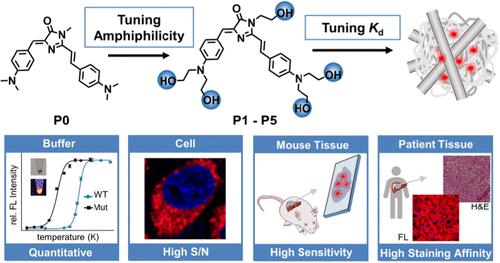当前位置:
X-MOL 学术
›
Anal. Chem.
›
论文详情
Our official English website, www.x-mol.net, welcomes your
feedback! (Note: you will need to create a separate account there.)
Tailoring the Amphiphilicity of Fluorescent Protein Chromophores to Detect Intracellular Proteome Aggregation in Diverse Biological Samples
Analytical Chemistry ( IF 6.7 ) Pub Date : 2023-07-28 , DOI: 10.1021/acs.analchem.3c01903
Mengdie Wang 1, 2 , Zhenduo Zhang 1, 3 , Biao Jing 1, 3 , Xuepeng Dong 3 , Kun Guo 3 , Jintai Deng 1, 3 , Zhiming Wang 1, 3 , Wang Wan 1 , Wenhan Jin 1 , Zhenming Gao 3 , Yu Liu 1
Analytical Chemistry ( IF 6.7 ) Pub Date : 2023-07-28 , DOI: 10.1021/acs.analchem.3c01903
Mengdie Wang 1, 2 , Zhenduo Zhang 1, 3 , Biao Jing 1, 3 , Xuepeng Dong 3 , Kun Guo 3 , Jintai Deng 1, 3 , Zhiming Wang 1, 3 , Wang Wan 1 , Wenhan Jin 1 , Zhenming Gao 3 , Yu Liu 1
Affiliation

|
The formation of amorphous misfolded and aggregated proteins is a hallmark of proteome stress in diseased cells. Given its lack of defined targeting sites, the rational design of intracellular proteome aggregation sensors has been challenging. Herein, we modulate the amphiphilicity of fluorescent protein chromophores to enable selective detection of aggregated proteins in different biological samples, including recombinant proteins, stressed live cells, intoxicated mouse liver tissue, and human hepatocellular carcinoma tissue. By tuning the number of hydroxyl groups, we optimize the selectivity of fluorescent protein chromophores toward aggregated proteins in these biological samples. In recombinant protein applications, the most hydrophobic P0 (cLogP = 5.28) offers the highest fold change (FC = 31.6), sensitivity (LLOD = 0.1 μM), and brightness (Φ = 0.20) upon binding to aggregated proteins. In contrast, P4 of balanced amphiphilicity (cLogP = 2.32) is required for selective detection of proteome stresses in live cells. In mouse and human liver histology tissues, hydrophobic P1 exhibits the best performance in staining the aggregated proteome. Overall, the amphiphilicity of fluorescent chromophores governs the sensor’s performance by matching the diverse nature of different biological samples. Together with common extracellular amyloid sensors (e.g., Thioflavin T), these sensors developed herein for intracellular amorphous aggregation complement the toolbox to study protein aggregation.
中文翻译:

定制荧光蛋白发色团的两亲性以检测多种生物样品中的细胞内蛋白质组聚集
无定形错误折叠和聚集蛋白质的形成是患病细胞中蛋白质组应激的标志。由于缺乏明确的靶向位点,细胞内蛋白质组聚集传感器的合理设计一直具有挑战性。在此,我们调节荧光蛋白发色团的两亲性,以选择性检测不同生物样品中的聚集蛋白,包括重组蛋白、应激活细胞、中毒小鼠肝组织和人肝细胞癌组织。通过调整羟基的数量,我们优化了荧光蛋白发色团对这些生物样品中聚集蛋白的选择性。在重组蛋白应用中,疏水性最强的 P0 (cLogP = 5.28) 在与聚集蛋白结合后可提供最高的倍数变化 (FC = 31.6)、灵敏度 (LLOD = 0.1 μM) 和亮度 (Φ = 0.20)。相比之下,选择性检测活细胞中的蛋白质组应激需要平衡两亲性 (cLogP = 2.32) 的 P4。在小鼠和人类肝脏组织学组织中,疏水性 P1 在聚集蛋白质组染色方面表现出最佳性能。总体而言,荧光发色团的两亲性通过匹配不同生物样品的多样性来控制传感器的性能。与常见的细胞外淀粉样蛋白传感器(例如硫磺素T)一起,本文开发的用于细胞内无定形聚集的传感器补充了研究蛋白质聚集的工具箱。
更新日期:2023-07-28
中文翻译:

定制荧光蛋白发色团的两亲性以检测多种生物样品中的细胞内蛋白质组聚集
无定形错误折叠和聚集蛋白质的形成是患病细胞中蛋白质组应激的标志。由于缺乏明确的靶向位点,细胞内蛋白质组聚集传感器的合理设计一直具有挑战性。在此,我们调节荧光蛋白发色团的两亲性,以选择性检测不同生物样品中的聚集蛋白,包括重组蛋白、应激活细胞、中毒小鼠肝组织和人肝细胞癌组织。通过调整羟基的数量,我们优化了荧光蛋白发色团对这些生物样品中聚集蛋白的选择性。在重组蛋白应用中,疏水性最强的 P0 (cLogP = 5.28) 在与聚集蛋白结合后可提供最高的倍数变化 (FC = 31.6)、灵敏度 (LLOD = 0.1 μM) 和亮度 (Φ = 0.20)。相比之下,选择性检测活细胞中的蛋白质组应激需要平衡两亲性 (cLogP = 2.32) 的 P4。在小鼠和人类肝脏组织学组织中,疏水性 P1 在聚集蛋白质组染色方面表现出最佳性能。总体而言,荧光发色团的两亲性通过匹配不同生物样品的多样性来控制传感器的性能。与常见的细胞外淀粉样蛋白传感器(例如硫磺素T)一起,本文开发的用于细胞内无定形聚集的传感器补充了研究蛋白质聚集的工具箱。

































 京公网安备 11010802027423号
京公网安备 11010802027423号